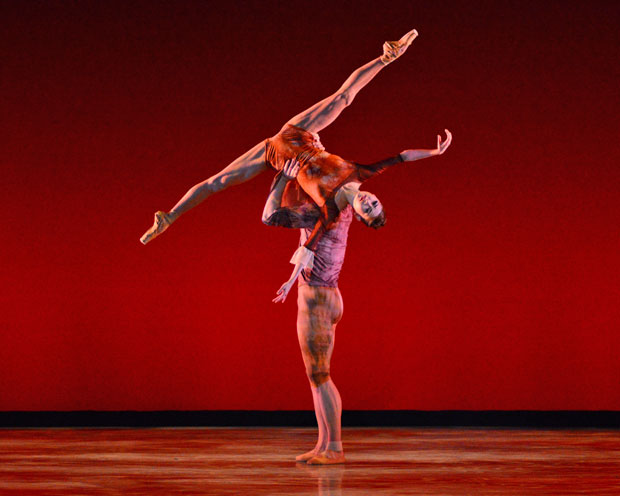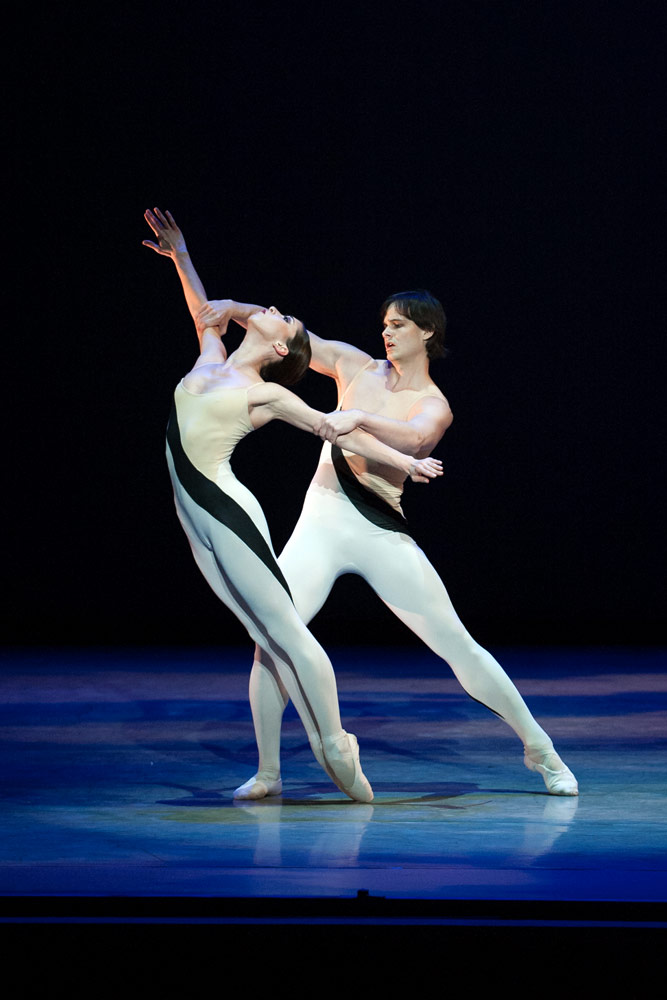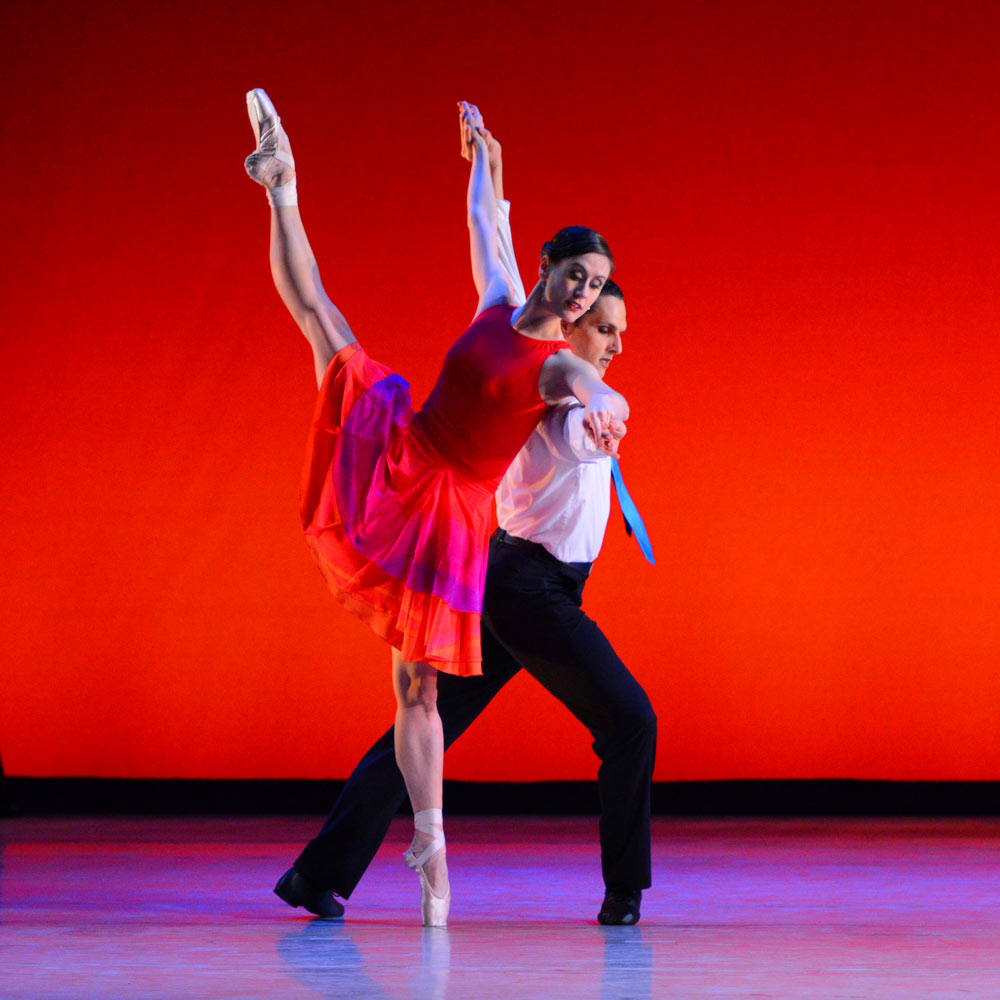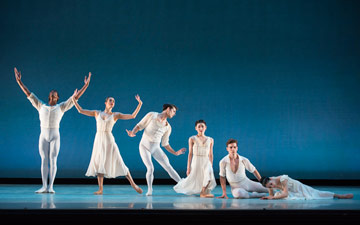
© Theo Kossenas. (Click image for larger version)
Washington Ballet
Tour-de-Force: Balanchine!
Theme and Variations, D-Construction, Opposites Distract, Together Apart, and duets from Momentum, Flames of Paris, Diana and Actaeon, Rooster, As Above, So Below
Washington, Kennedy Center Eisenhower Theater
25 April 2014
www.washingtonballet.org
www.kennedy-center.org
In his traditional pre-performance remarks, Septime Webre, artistic director of The Washington Ballet, described Tour-de-Force: Balanchine! – a new program the company brought to the Kennedy Center’s Eisenhower Theater in April – as “exciting and personal.”
Indeed, The Washington Ballet’s premiere of George Balanchine’s Theme and Variations, which ended the evening, generated a great deal of excitement and was undoubtedly one of the most thrilling offerings of the troupe’s current season.
Nevertheless, I found more pleasure in the first half of the program, the “personal” one, which proved not only a potent showcase of the company’s dancing power but also a celebration – and a tribute – to the choreographic forces of the company.
The gala formula really worked. An eclectic selection of dances – six duets and three short ballets – offered something for almost every taste: from the old chestnuts of the classical repertory (excerpts from Vasili Vainonen’s Flames of Paris and Marius Petipa’s Diana and Actaeon) to a wide assortment of contemporary pieces, including works created by the choreographers closely associated with the company.

© Theo Kossenas. (Click image for larger version)
The late Choo-San Goh had defined and etched the image and style of the Washington Ballet and propelled the troupe to international prominence in the 1980s. He was resident choreographer from the company’s inception in 1976 until his untimely death in 1987.
A pas de deux from his signature piece, Momentum, rapturously performed by Kateryna Derechyna and Tamás Krizsa, was a fitting tribute to Goh’s choreographic legacy.
This subtle duet, set to the andante movement of Sergei Prokofiev’s Piano Concerto No.1, is a vivid example of Goh’s singular choreographic style of wondrous and fluidly sculptured movements. Derechyna and Krizsa brought to the fore the inner musicality and spaciousness of the choreography as they dreamed through sinuous and serenely-paced steps with exquisite articulation, sustaining a delicate balance of sensuality and restraint.

© Theo Kossenas. (Click image for larger version)
This season Septime Webre celebrates his 15th anniversary as artistic director of the Washington Ballet. 2014 also marks his 25th anniversary as a choreographer. And there is no better way to commemorate the occasion than to dust off the piece which started it all: a vigorous quartet for male dancers, D-Construction was Webre’s first major choreographic attempt.
According to the choreographer, D-Construction was influenced by the musical tastes and movement aesthetics of Merce Cunningham, whom Webre regards as one of his major inspirations. In it, with notable skill, he translates the inexorable energy and pulsating beat of the score – John Cage’s propulsive Third Construction (1941) – into a high-spirited aerobic romp, pushing the dancers on and off the stage without a breather.
Dressed in black sporty costumes, the well-rehearsed quartet – Jared Nelson, Andile Ndlovu, Daniel Savetta and Daniel Roberge – brought into sharp focus their solid technical skills as well as their great stamina. The dancers dashed, turned, and leaped on stage amid the percussive rush, tearing into Webre’s highly athletic choreography with nearly manic determination and zeal.
Elaine Kudo, former soloist of American Ballet Theatre, is presently ballet master of the Washington Ballet. Her quirky and utterly enjoyable piece for two couples, aptly titled Opposites Distract (1999), was premiered by the company last year. It’s a smartly-conceived crowed-pleaser which re-creates, with wit and playfulness, the animated and sexually-charged atmosphere of a night club, and explores the comic and dramatic outcomes of unexpected romance amid dance-partner swapping.

© Paul Wegner. (Click image for larger version)
The irresistible, flamenco-flavored music by German-born guitarist and songwriter Ottmar Leibert, from his 1990 record “Nouveau Flamenco,” gives a jolt of exuberance to the vividly theatrical choreography which infuses the ballroom and classical steps with male swagger and female sexual allure.
The piece rendered a slew of memorable moments as two couples (Aurora Dickie and Luis R. Torres, Morgann Rose and Zachary Hackstock) took center stage, channeling their fleeting romantic attractions to amusing effect. In one scene, the tantalizing Rose waved the skirt of her scarlet dress in front of the macho-looking Torres like a matador enticing the bull with a cape. The dancers relished every moment of their performance, and so did the audience. The infectiously tuneful song “2 the Night” was the starring attraction of the soundtrack.
Hungarian-born Tamás Krizsa is in his seventh season with the company. Together Apart is his choreographic debut. Small in scale but mighty in effect, this evanescent pas de deux was inspired by the music to which it is set – a hauntingly beautiful excerpt from the award-winning soundtrack to the TV series “Arrow” by American composer Blake Neely.

© Theo Kossenas. (Click image for larger version)
As Krizsa told me, when he heard this music for the first time, he immediately knew that one day he would make a dance to it. He created this piece for himself and his partner on stage and off, Maki Onuki. So it came as no surprise that the well-tailored choreography pushes both dancers to the limits, emphasizing their versatility and technical prowess. At the same time, despite its virtuosic edge, the duet felt deeply emotional and sincere.
The petite and supple Onuki is a technical marvel, yet also a fearless dancer. The audience was in awe watching her hovering above the stage in a breathtaking display of transfixing lifts and holds. In one stunning image, she curled herself in a deep backbend while raised into space by her partner, both dancers bathed in a soft haze of golden light. Apart from showing off their technical talents, the dancers performed with a keen sense of subtlety and allure, casting a spell all their own and compelling the audience to a standing ovation.
After the intermission, Balanchine’s 1947 masterpiece, Theme and Variations, received a respectable treatment from the cast led by Onuki and Corey Landolt. Here the dancers found themselves in somewhat uncharted territory, as opposed to the stylistic comfort zone they enjoyed during the program’s first half. Still, for the most part, the 26-member ensemble rose to the occasion admirably.

© Paul Wegner. (Click image for larger version)
The radiant Onuki, clad in a sumptuous tutu, was all poise and glamour – a stark contrast to her gravity-defying comportment in Together Apart. She was ably partnered by the gallant Landolt as they moved through the magical world of music and movement conjured by Tchaikovsky and Balanchine. The couple’s youthful vitality and excitement, plus the genuine ardor of their dancing, made their performance all the more memorable and unique.

















You must be logged in to post a comment.